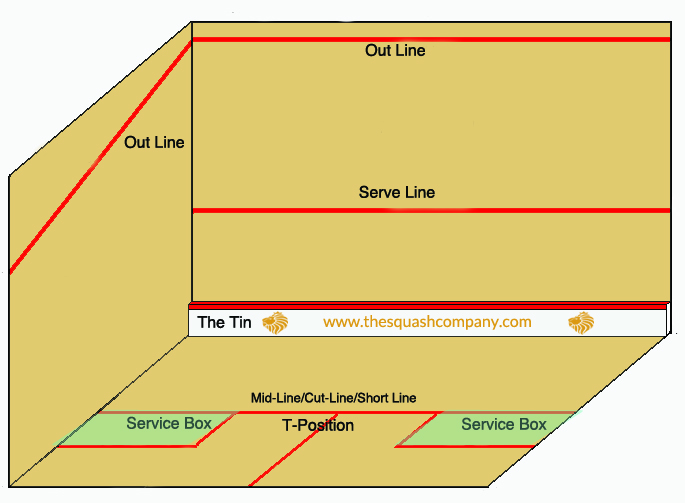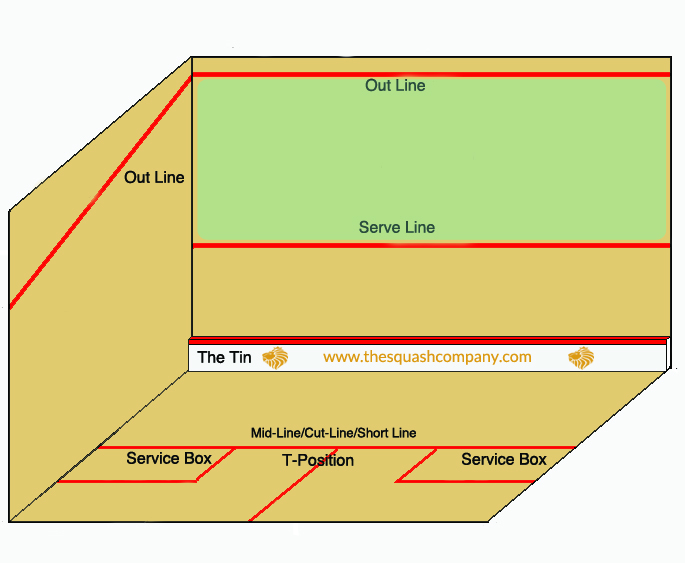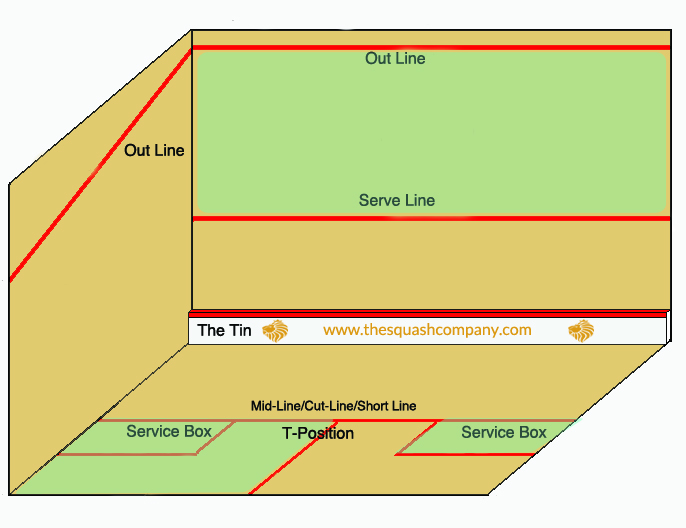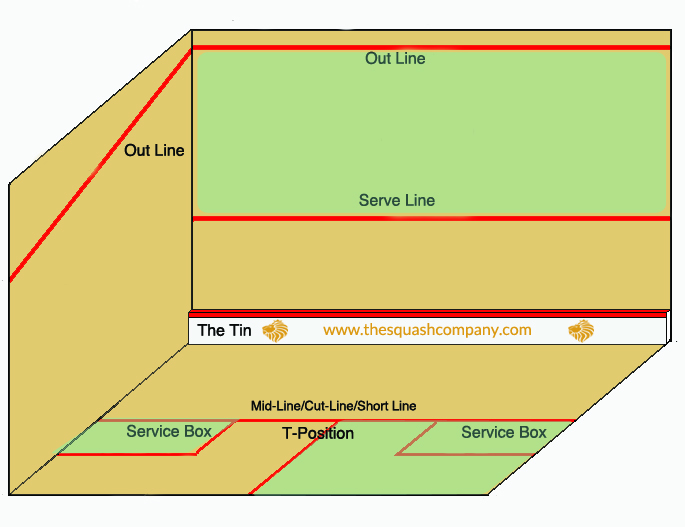The basics
Please note that the following text is a simplified take on the rules of squash and not the complete version. They will however be more than enough to get you going! To see the full rules for squash, visit the World Squash Federation rules here.
Court lines
Below is a map of the court with all of the main areas labeled and highlighted: 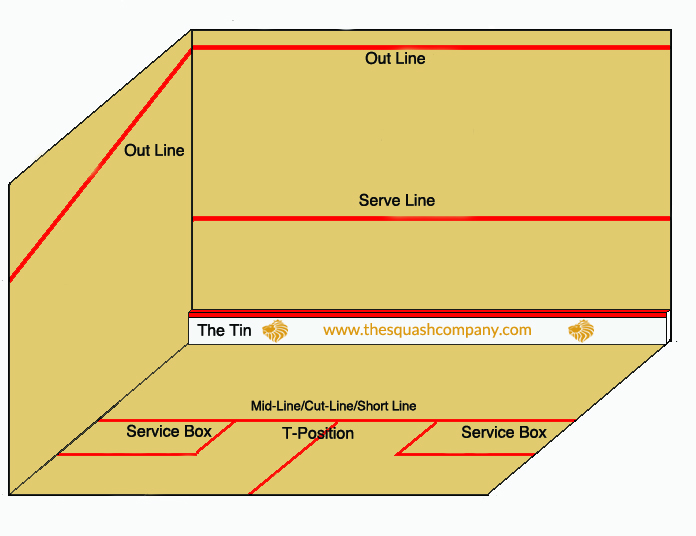
General Rules of Play
- You can only hit the ball once before your opponent hits it. The contact must also be singular; you cannot ‘carry’ the ball.
- The ball can only bounce once on the floor.
- You must make every effort to clear your shot and ensure your opponent has room to play their shot. We will come onto this in detail in the Obstruction, Interference and Safety section below.
Scoring
- There are two ways of scoring. In PAR (Point-A-Rally or American scoring), played by junior and professionals, players play to 11 points and are able to score points regardless of who serves. In ‘English’ or ‘Serve-In’ scoring, players have to win a rally while they are serving to score a point. ‘Serve-In’ games are played to 9 points.
- In a match, players play best of five games.
- In PAR scoring, if the game is tied at 10-10, players have to win by 2 clear points, e.g., 12-10, 13-11, 14-12, etc. In ‘Serve-In’/English scoring, if the score reaches 8-8, the player who is receiving serve decides whether to play to 9 or 10 by saying either ‘1’ or ‘2’. There is no requirement to win by 2 clear points in this scoring system.
In or out?
The ball can hit any of the walls first but it must always hit the front wall before it hits the floor. If it doesn’t, it is out. If the ball hits any of the lines at the top of the court or the Tin, the red line and boards at the bottom of the front wall, it is out. 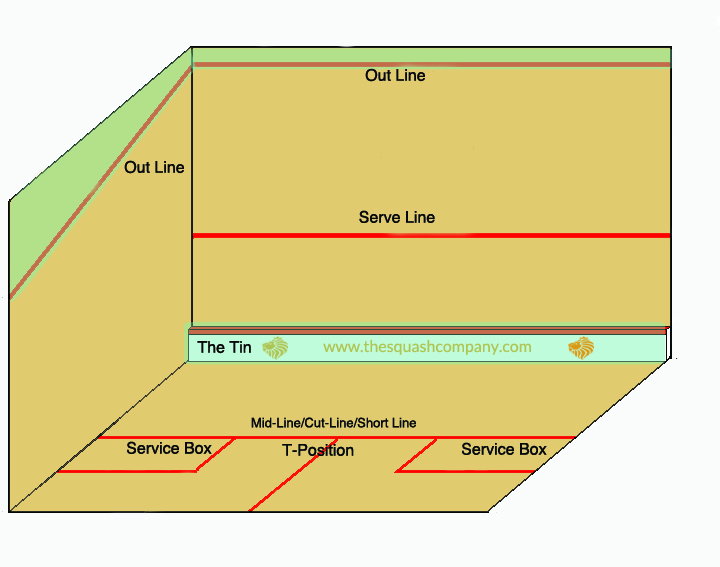 Service Rules
Service Rules
- You only get one serve in squash so take your time. However, if a player makes no contact with the ball, it does not count as a serve and theoretically, this could happen over and over again.
- You must serve the ball from one of the two service boxes. When you serve, you must have at least one whole foot in the box and in contact with the floor or it is a ‘Foot Fault’ and you lose the point.
- The person who wins the rally serves at the start of the next rally. To decide who serves the first point, players will typically spin their racket using the brand/logo/symbol on the butt of their racket to decide, e.g., the dunlop arrow will point either left or right when it lands, so a player offers their partner ‘left or right’ and then spins the racket.
- At the start of a new game, the person who won the last game serves.
- The first time you win the service back you can choose which side to serve from. If you win the point, you must then serve from the other side and keep swapping so long as you keep winning consecutive points.
Service: In or Out?
- Your serve must go above the service line – the middle line on the front wall – and below the out line (the top line on the front wall).
- The serve must go to your opponent’s quarter of the court. The ball can hit the side wall or the back wall before hitting the floor of the quarter.
- If you serve from the left service box, your serve must go to the back quarter of the right side of the court. If you serve from the right service box, your ball must go to the back left hand quarter of the court.
Obstruction, Interference, and Safety
- After playing a shot, you must make every effort to get out of the way and allow your opponent freedom to play the ball and play any reasonable shot they wish.
- If you feel that you are obstructed or impeded by your opponent, you must say ‘Let ball, please’ or ‘Please’ and NOT play the ball. If you play the ball, you cannot receive a ‘Let’ or ‘Stroke’ unless the obstruction came, or there was contact, as you played the shot.
- The referee/marker or the players must then decided whether it is a ‘Let Ball’, a ‘Stroke Ball’ or a ‘No Let’.
‘Let Ball’
In general, a player is awarded a ‘Let Ball’ if the obstruction takes place as they are travelling towards the ball but are not yet ready to play the shot or could not play play a shot towards the side wall. A ‘Let Ball’ is also awarded if a player serves before their opponent is ready. A ‘Let Ball’ can also be given if the players/referee/marker are unsure of the outcome of a point e.g. not sure if the ball was out or not.
When a ‘Let Ball’ is given, the point is replayed.
‘Stroke Ball’
A ‘Stroke Ball’ is when a player is ready to play a shot, that would likely be a winning shot, towards the front wall, but is unable to because there is a very high chance they would either strike their opponent with the racket or the ball if they played the shot. If a player does play the ball and hits their opponent with the ball on it’s way to the front wall, the person who played this shot is given a ‘Stroke Ball’ (if it’s on the way to the side wall or hits an opponent after coming off the side wall it is a let ball). A ‘Stroke Ball’ is also given if a player does strike their opponent with their racket while playing a shot. However, this doesn’t mean you can just hit the ball at your opponent. If you are awarded three strokes for striking your partner you forfeit the game. When a ‘Stroke Ball’ is given, the point is awarded to the person who would’ve/did hit the ball.
‘No Let’
A ‘No Let’ is given when the player who asks for a ‘Let Ball’ is deemed to have not been in a position to get the ball back before it bounced twice. This can happen if the ball was too far away from them or if would be impossible to return, e.g., it hit the nick or was too tight to the side wall. When a ‘No Let’ is given, nothing changes and play continues.
